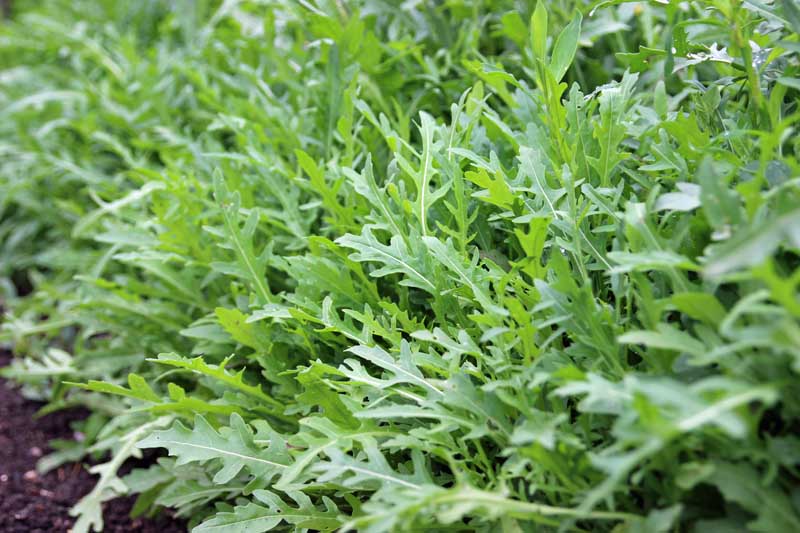Arugula or rocket in the UK is one of the vegetables rich in nutrients and vitamins that are beneficial to human health. This vegetable prefers cool temperatures, so gardeners will often plant Arugula in the spring and fall. When temperatures are cool, Arugula will have ideal growing conditions and produce flavorful leaves. However, can we grow Arugula in the summer? What should you keep in mind about growing arugula in summer? Does high temperature cause Arugula to change its flavor? Join us to learn the details in this article.
Growing Arugula In Summer: How To Be Successful?
Yes! You can successfully grow Arugula in the summer if you choose a vegetable variety that can withstand high temperatures, take measures to protect the Arugula from the sun, and water the Arugula regularly.
Choose Vegetable Varieties That Can Withstand High Temperatures
Arugula will grow best in temperatures between 45 and 75 degrees F. Therefore, temperatures that are too high in the summer will cause Arugula to wilt and affect the growth rate of the plant. In addition, high temperatures will also affect the flavor of Arugula, making it chewy, bitter, and strong.
To successfully grow Arugula in the summer, you need to pay attention to the Arugula variety. You should choose Arugula vegetable varieties that can withstand high temperatures and have good quality. Information about varieties, temperature, and nutrition of Arugula vegetable varieties will be printed on the product packaging. Therefore, you need to research and choose vegetable varieties that are suitable for the temperature in the area where you live in the summer.

Avoid Sunlight And High Temperatures For Seeds, Young Plants, And Mature Plants
After you have chosen the Arugula variety suitable for summer, you still need to find ways to protect against sunlight and reduce the temperature from sowing the seeds until transplanting the seedlings to the outside environment. Arugula seeds will germinate best at temperatures between 70 degrees F and will not germinate at temperatures above 85 degrees F. Therefore, in the summer you will not be able to sow seeds directly outside due to high temperature.
Instead, you need to plant seeds in trays or containers indoors or in a cool environment. You need to improve the quality of the soil, make it moist, and loose and add nutrients. Then, you plant the seeds and keep the soil continuously moist for the next few days. After germination, seeds will be extremely weak and vulnerable to the negative effects of weather such as high temperatures, strong winds, and heavy rain. Therefore, during the young tree stage, you need to regularly check and monitor their progress.
After 4 to 6 weeks, the Arugula seedlings will be ready to start transplanting into the ground outside. However, they will wilt or die due to sudden environmental changes. Therefore, you need to expose the seedlings to the outside environment for 15 minutes, 30 minutes, up to 1 hour, 2 hours, or 3 hours every day. This process can take 2-3 weeks to help the seedlings adapt to the outside environment.
To increase the survival rate of seedlings when transplanted into the ground outside, you need to choose an area with sunlight for about 6 hours a day and cool shade in the afternoon. Therefore, you can grow Arugula in the shade of larger plants such as corn, okra, or sunflowers. The shade of these plants will protect Arugula from harsh sunlight and high temperatures in the outside environment.
Read this post: When To Harvest Arugula Seeds
Water Regularly And Maintain Humidity
Regular watering is one of the important factors to help Arugula survive during high-temperature days. When the soil is always moist, Arugula will not wilt under the harsh summer sun. On high-temperature days, the water evaporation rate will be faster, so you need to water twice a day in the morning and afternoon to maintain moisture in the soil. You should not water at noon when the temperature is high because the water can be hot and cause the Arugula to wilt.
In particular, if you grow Arugula in a container outside during the summer, you will need to water more often because the drainage rate in the container will be faster than usual. Use your finger or a moisture meter to check the moisture in the soil. In addition, you need to check the moisture in the soil before watering to avoid waterlogging problems. Waterlogging will cause root rot and serious damage to vegetable plants.
To keep moisture in the soil for Arugula, you can cover it with a layer of straw or dry leaves to reduce the rate of water evaporation outside the environment. Mulch not only helps retain soil moisture but also creates additional shade for Arugula on hot days. However, you should not create a layer of mulch that is too thick. Because it will prevent Arugula from photosynthesizing and exchanging air in the natural environment outside.
Conclude
Arugula is a plant that prefers cool temperatures, so its growing season is spring and fall. However, you can still grow Arugula in the summer if you take measures to protect it from the sun and keep it moist. You need to choose an Arugula variety that can withstand high temperatures in the summer. Information about the Arugula vegetable variety such as heat resistance, seeding, germination, or harvesting time will be printed on the product packaging. Therefore, you need to choose the correct vegetable variety that is suitable for the temperature where you live.
You should plant Arugula in an area that gets at least 6 hours of sunlight a day and shade in the afternoon. Combine growing Arugula with some tall plants like corn, sunflowers, or okra. In addition, you also need to water Arugula regularly in the summer to keep the soil moist. Besides, they can prevent the vegetables from wilting during high-temperature days. Mulching with straw or dried leaves will also help retain moisture and protect Arugula from the sun during the summer.